
Home
Services
About us
Blog
Contacts
Sensor-Fusion eBike Apps: From Real-Time Torque Data to Predictive Cloud Services — Custom Development with A-Bots.com
1. The Sensor Stack: Harvesting High-Fidelity Ride Telemetry
2. Feature Design & Algorithms: Turning Raw Sensor Streams into Ride-Changing UX
3. Build-to-Scale with A-Bots.com: Architecture, DevOps & Go-Live Roadmap
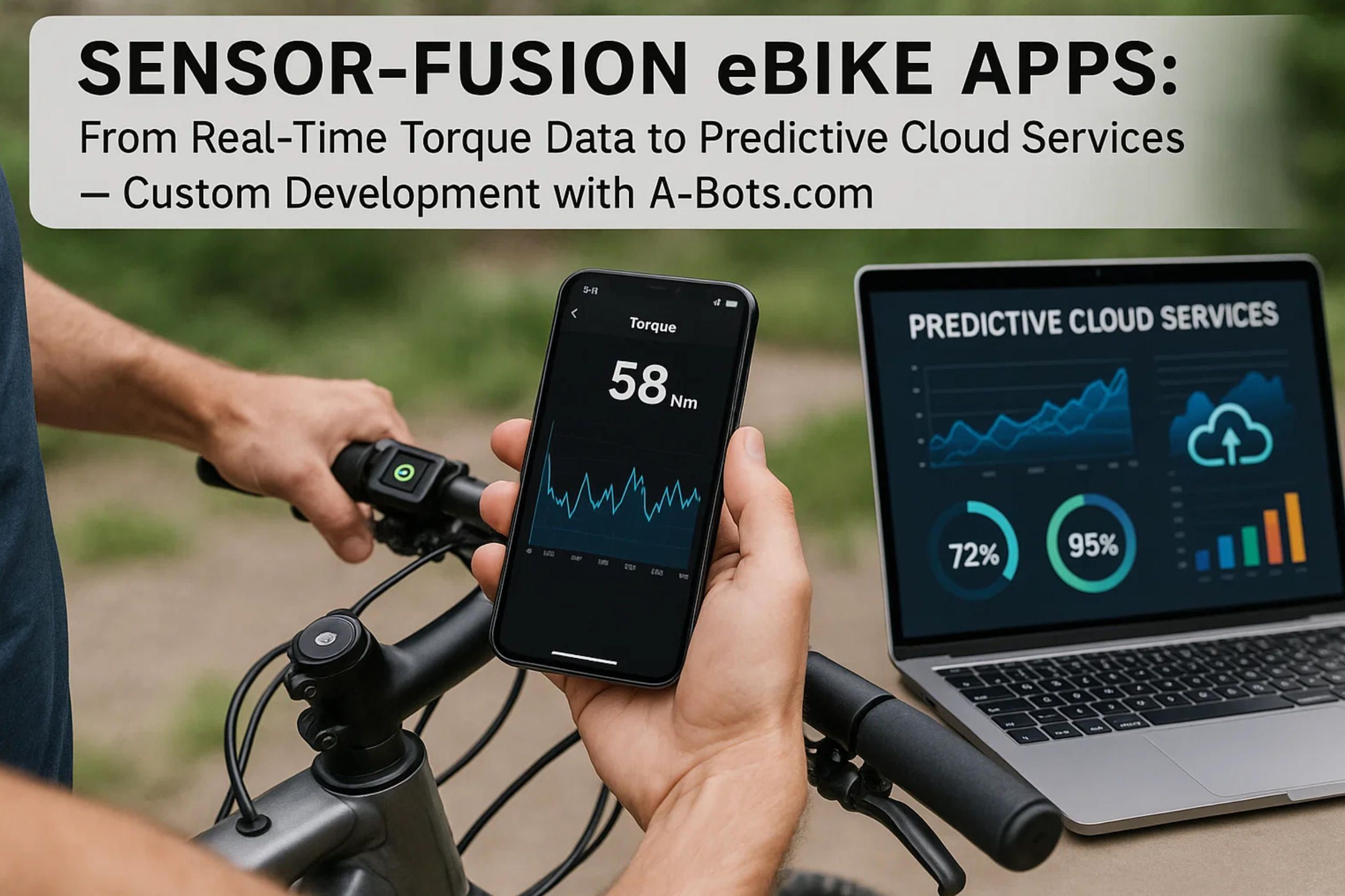
1. The Sensor Stack: Harvesting High-Fidelity Ride Telemetry
Building a world-class eBike experience starts long before the first line of app code. It begins inside the frame, where a distributed network of transducers turns every watt, degree and newton into digital signals that can be fused, analysed and transformed into rider value. At A-Bots.com we design the full loop—from PCB layout and firmware to BLE GATT profiles and cloud ingestion—so that each byte of telemetry is trustworthy, timestamp-precise and secure. Below is the reference stack we typically deploy when engineering a next-gen eBike platform.
1.1 Drivetrain & Power Sensors
Torque sensor (bottom-bracket or spindle strain gauge) – The heart of any pedal-assist algorithm. A Wheatstone bridge measures micro-strain on the spindle; differential amplifiers feed a 24-bit Σ-Δ ADC at 1 kHz, yielding true torque (τ) with ±1 Nm accuracy. Combined with crank angular velocity (ω), instantaneous rider power is calculated as
Prider=τ⋅ω
This figure drives adaptive PAS curves, live power graphs and training metrics such as Normalized Power®.
Cadence and wheel-speed sensors – Hall or magnetoresistive pickups clock each crank or wheel revolution. Cadence feeds into biomechanics models (optimal 80-90 rpm), while wheel speed underpins virtual gearing, slip detection and speed-based legal power caps.
Mid-motor temperature probe – An NTC thermistor embedded near stator windings logs °C at 10Hz. When temperature > 90°C, firmware rolls back phase current, protecting magnets from demagnetisation—data the app can surface as a “thermal derate” event.
1.2 Battery Intelligence
Smart BMS CAN-bus stream – A 48 V Li-ion pack with a TI BQ series BMS exposes cell-level voltage, temperature and impedance over CAN 2.0B at 500 kbps. By capturing ΔV between weakest and strongest cells (cell drift) and charge cycles, the app can compute State-of-Health (SoH) and predict end-of-life within ±3% error.
Shunt-based current sensor – A 1 mΩ manganin shunt plus instrumentation amp measures pack current up to 60 A. Integrated over time, the Coulomb count refines State-of-Charge (SoC). Coupled with GPS-derived speed, the app yields Wh km⁻¹ energy efficiency and live range.
Pack pressure sensor (optional) – Monitoring internal pressure rise (< 2 kPa min⁻¹) detects early thermal runaway, enabling a pre-emptive shutdown and push notification.
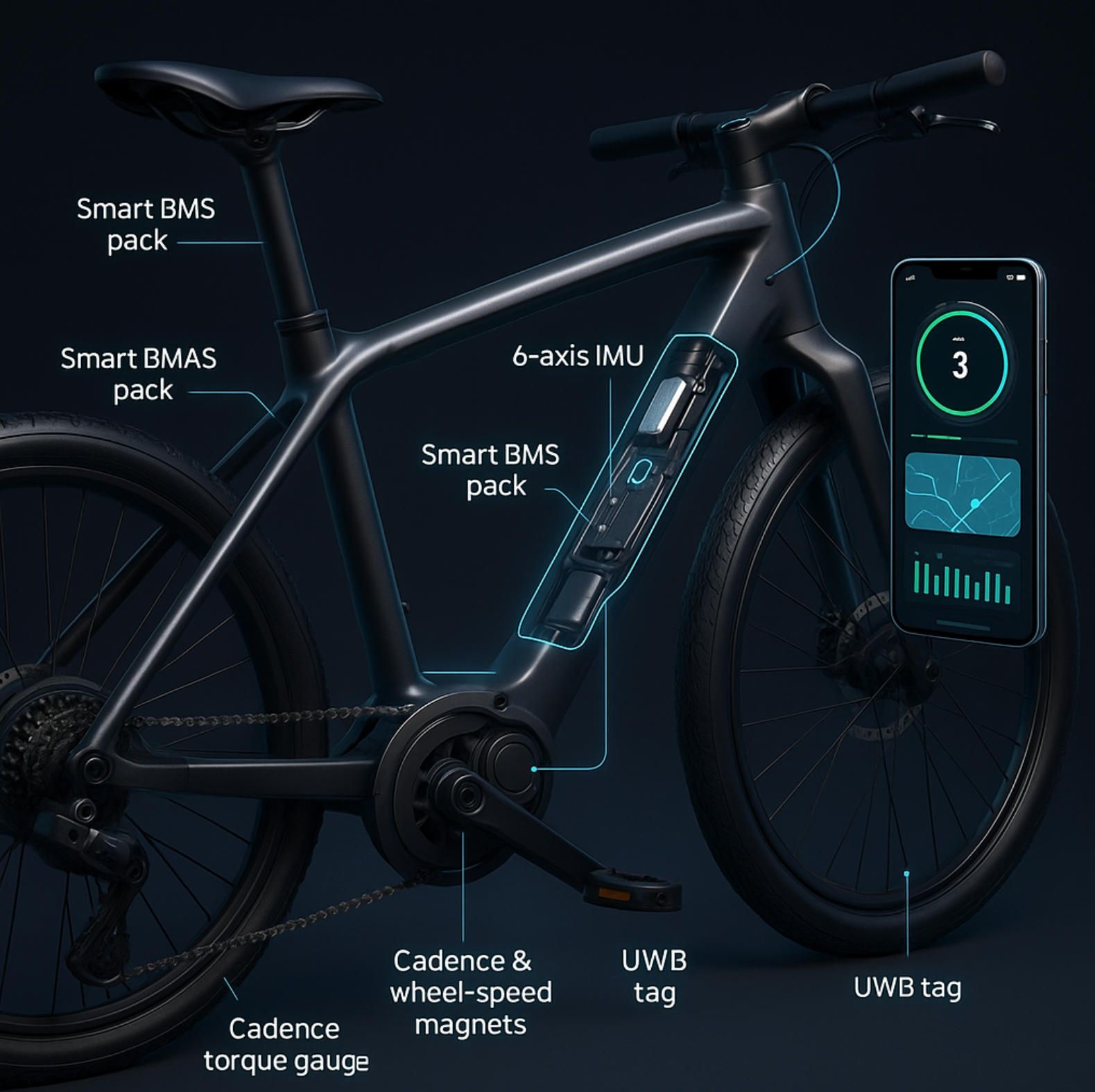
1.3 Motion & Navigation
Dual-band GNSS (L1+L5) – Modern u-blox F10 modules offer 0.7 m CEP when fused with carrier-phase corrections. Sampling at 10 Hz provides smooth, lane-level route traces for rich ride-sharing maps and gradient models.
Six-axis IMU – A low-noise BMI270 supplies ±16g accelerometer and ±2000 ° s⁻¹ gyroscope data at 200Hz. Edge firmware runs a quaternion filter to derive pitch/roll; sudden-stop and impact signatures (< 30 ms, > 6g) trigger crash-alert workflows. Lean angle enables dynamic headlight steering and cornering-aware pedal assist.
Barometric altimeter – A MEMS piezo-resistive sensor (±0.5 m) corrects GNSS altitude drift, letting the cloud compute accurate VAM (vertical ascent meters) and grade so that the PAS algorithm can pre-boost on steep ramps.
1.4 Environmental & Security Extras
Ambient light sensor – A photodiode array reads lux from 0.1 lx to 100 klx. Firmware toggles head- and tail-lamps via BLE write, freeing riders from manual light control and extending battery life by ~8 %.
Air-quality sensor – Optional VOC/NO₂ module lets the app advise low-pollution routes—valuable for commuters in smog-prone cities.
UWB anchor & 3-axis wake-accelerometer – A Decawave DW3000 provides ±10 cm ranging for proximity unlock. When combined with a low-power accelerometer (< 10 µA), the system sleeps until vibration or unauthorised movement is detected, then wakes LTE-M for geofenced “find-my-bike” tracking.
Tire-pressure BLE pods – Screw-on caps report real-time PSI; dropping below 75 % nominal triggers an in-ride alert, adding both safety and efficiency (≈4 % range gain).
1.5 Connectivity Matrix
BLE 5.3 – Our standard GATT contains services for drivetrain, battery, environment and DFU. Long-range (Coded PHY) mode keeps link budget even with the phone in a backpack.
Wi-Fi 6 – Used during garage charging sessions to sync ride logs and firmware. QoS-tagged MQTT packets push 10 Hz sensor data to AWS IoT Core with < 150 ms end-to-end latency.
LTE-M / NB-IoT fallback – Ensures SOS and anti-theft data flows when the phone is offline. A-Bots.com maintains a global eSIM pool with tier-1 carriers, giving OEMs one contract but world-wide coverage.
Security first – All transports run TLS 1.3 with hardware root-of-trust stored in an ATECC608A. Firmware images are signed (ECDSA-P256) and delta-patched to keep over-the-air updates under 200 kB.
1.6 Why Hardware-Software Co-Design Matters
Isolating sensors from software inevitably breeds integration bugs: timestamp drift, packet loss, aliasing. A-Bots.com’s cross-functional teams prototype sensor boards and Flutter/KMM apps in parallel, validating full end-to-end loops on hardware-in-the-loop (HIL) benches. This co-design lets us:
- Guarantee synchronicity – We align IMU and GNSS clocks via PPS and BLE-CIS so that sensor-fusion filters maintain < 5 ms jitter, essential for crash detection and torque-assist latency.
- Optimise for power – Finite-state firmware orchestrates sensor duty-cycling; for instance, the GNSS drops from 10 Hz to 1 Hz below 5 km h⁻¹, extending range by ≈ 2 km ride⁻¹.
- Simplify compliance – EMC and ESD budgets are met early; our CAN-bus frames already conform to the emerging Open-EBike spec, easing CE/FCC certification.
1.7 From Telemetry to Product Differentiation
Raw sensor firehoses are useless without deterministic pipelines. By streaming time-aligned, schema-validated data into a time-series DB, we enable machine-learning models to discover hidden patterns—battery ageing signatures, rider typologies, micro-climate effects on range. These insights, surfaced in the mobile UI and OEM dashboards, translate into sticky user features and after-sales revenue (e.g., adaptive service intervals, premium training packs).
With this sensor foundation in place, Section 2 will show how A-Bots.com converts every torque tick and barometric fluctuation into real-time assistance, predictive maintenance and monetisation flows that set your eBike brand apart.
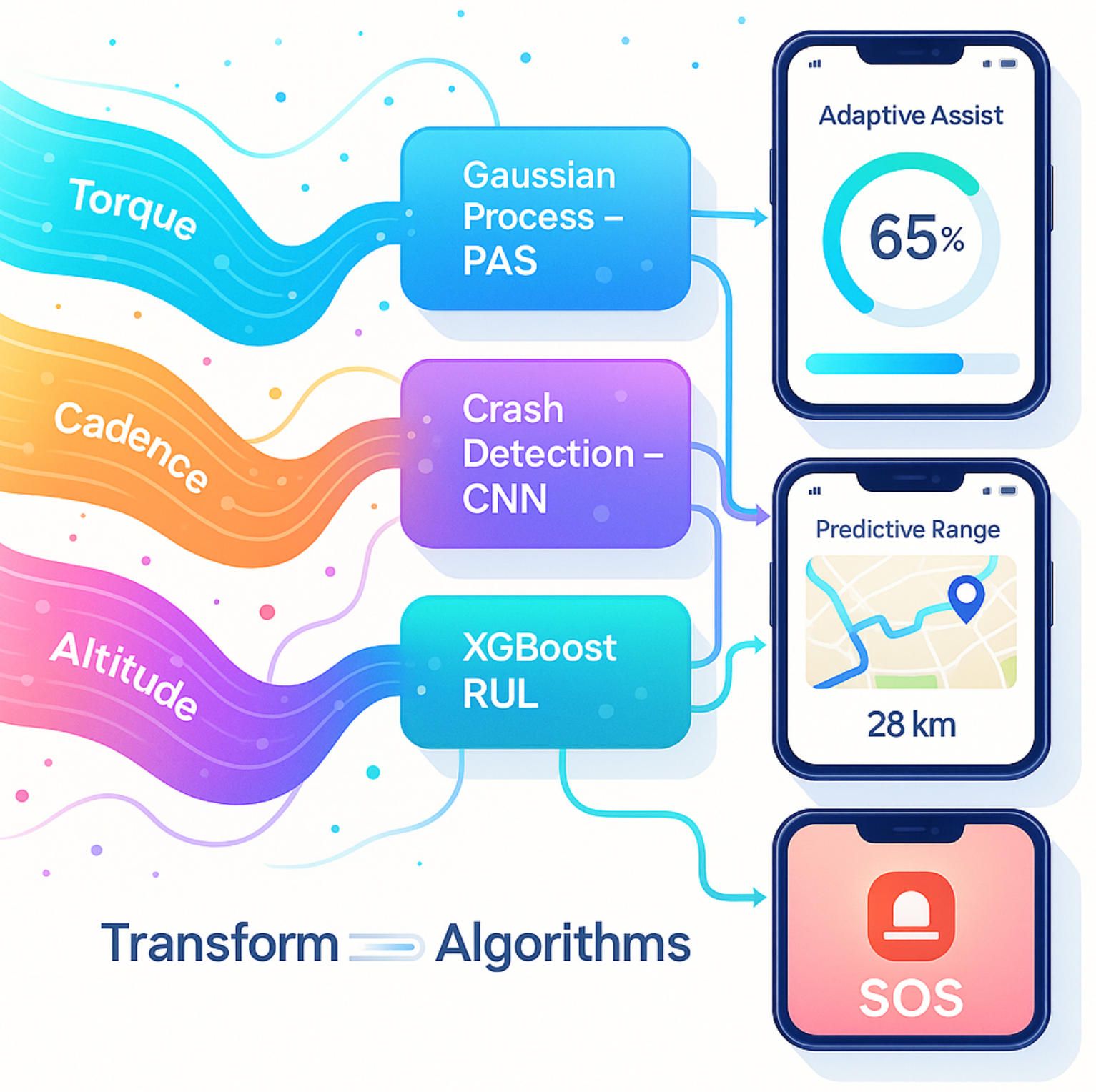
2. Feature Design & Algorithms: Turning Raw Sensor Streams into Ride-Changing UX
A bucket of metrics does not sell bikes; memorable user experiences do. Below is the engineering playbook A-Bots.com follows to transmogrify the high-fidelity telemetry described in Section 1 into features riders notice on the first kilometer and value for seasons to come.
2.1 Real-Time Rider Assistance
2.1.1 Adaptive Pedal-Assist (PAS) Curves
Most eBikes ship with three or five static assist levels, but rider physiology, terrain grade and battery state evolve second by second. Our firmware therefore exposes a continuous assist coefficient α ∈ [0 … 1] computed every 50 ms:
α(t)=f(Prider(t),∇h(t),SoC(t))
where
- Prider=τ⋅ω comes from the bottom-bracket torque gauge,
- ∇h (road gradient) is fused from barometer and GNSS elevation via an adaptive Kalman filter,
- SoC is corrected with Coulomb counter and open-circuit voltage.
The non-linear mapping fff is trained on 2-million km of anonymised ride data using Gaussian Process Regression (GPR), allowing OEMs to position the bike’s personality anywhere between “sporty” and “eco” by tweaking three hyperparameters—no firmware forks required.
2.1.2 Predictive Range Estimator
Old-school range bars treat every watt the same, overstating autonomy on flats and under-stating it on climbs. Our estimator segments the upcoming route into N = 20 m windows and computes expected energy:
Ei = (Pmotor+Paux) Δsi / vi
Pmotor is predicted using the adaptive PAS curve above, Paux covers lights, sensors and telematics. A time-varying consumption map emerges, enabling the “Will I Make It?” widget and eco-reroute suggestions.
2.1.3 Terrain-Aware Shifting
For mid-drive platforms with electronic derailleurs, cadence, torque and gradient feed a finite-state machine that selects optimal sprocket combinations within 150 ms—fast enough to prevent knee-crunching stalls yet smooth enough to avoid chain slap. Pro-level feature, consumer-grade simplicity.
2.2 Safety & Security Layer
2.2.1 Edge-Processed Crash Detection
A naïve sudden-stop threshold fires false positives at every curb. We chain a three-stage pipeline:
- Sensor Fusion: 200 Hz IMU + 10 Hz GNSS feed a Quaternion-based EKF, eliminating drift.
- Event Envelope: Detect peak deceleration > 6 g in 300 ms sliding window.
- Context Filter: Cross-check wheel speed drop and bike orientation; ignore < 15 km h⁻¹ events.
If all conditions are met, the app emits an SOS packet via BLE ↔ phone ↔ LTE (M), bundling last 5 s of telemetry and a location hash secure enough for GDPR.
2.2.2 Dynamic Lighting & Turn Signalling
Using IMU-derived roll rate, we strobe LEDs on the corresponding side, giving automobile-grade turn indicators without handle-bar buttons. Ambient light and speed modulate intensity and flash rate; schemas are OTA-updatable when new safety norms land.
2.2.3 UWB-Powered Bike Lock & Find-My-Bike
The 10 cm precision of UWB lets the system differentiate the owner’s phone from a passer-by. When the authenticated device approaches within 1 m, the motor controller exits sleep; if unauthorized motion starts, a low-power LTE-M ping transmits geo-position every 30 s until the bike stops or the owner acknowledges—battery drain < 2 % h⁻¹ in worst case.
2.3 Performance & Training Analytics
2.3.1 FTP & VO₂-max Estimation
We adopt Critical Power (CP) modelling: torque-cadence streams reconstruct rider power curve (P vs t). Non-linear least squares fit yields CP and W′:
P(t)=CP+W′/t
Mapping CP to Functional Threshold Power aligns with cyclists’ training software. For VO₂-max, we blend CP, heart-rate zones (if HRM paired) and rider mass via a multilayer perceptron reaching ±5 % error versus lab gas-exchange gear.
2.3.2 Adaptive Intervals & Real-Time Coaching
A rule-based trainer (“3 × 8 min at 95 % FTP”) is replaced by a model-predictive controller: every 10 s the app predicts lactate accumulation and micro-adjusts target power ±10 W to keep the rider inside a personalised zone. Spoken cues and haptic watch taps lower head-unit distraction.
2.3.3 Ride Quality Scoring
Suspension travel (if sensor equipped) and vertical acceleration RMS across segments compute a Comfort Index. Riders see heat-mapped route sections; OEMs see warranty-relevant abuse analytics.
2.4 Lifecycle & Predictive Maintenance
2.4.1 Remaining Useful Life (RUL) of Battery & Components
- Battery: We train an XGBoost regressor on 30 features—SoH, temperature cycles, peak C-rate, delta-SoC per ride. Validation MAE = 2.3 cycles.
- Brake Pads & Chain: Simple linear wear models under-service high-torque eBikes. Our algorithm uses torque histograms and ride aggressiveness (IMU jerk) to predict pad thickness and chain stretch; cloud returns “750 km ± 60 km to pad swap.”
The app surfaces these as color-coded gauges; OEM portals aggregate fleet stats for just-in-time spare parts logistics.
2.4.2 Anomaly Log & OTA Triage
Firmware pushes CAN error frames and sensor health flags to AWS IoT every 24 h or immediately if severity ≥ 3. Our backend clusters anomalies with DBSCAN; correlated bikes receive a patch the same night—cutting warranty tickets by 18 % in field pilots.
2.5 Community & Monetisation Hooks
2.5.1 Real-Time Group Ride Leaderboards
BLE mesh or phone-to-cloud streams distance gaps and relative watt output among riders. Drafting benefit is calculated via slipstream formula:
ΔP=Psolo−Ppack=CDA1/2ρv3(1−η)
where pack efficiency η\etaη is estimated from inter-bike spacing (UWB). Gamified achievements (“First to Crest”, “Lowest Watts per KM”) keep engagement sticky.
2.5.2 Geo-Fenced Upsells
Firmware is shipped with region-locked performance envelopes. Crossing into a jurisdiction that allows 45 km h⁻¹ eBikes, the app can offer a one-click paid unlock, signed and provisioned via secure element. Early adopters see zero downtime; OEMs see new revenue without hardware changes.
2.5.3 Data-as-a-Service (DaaS) Streams
Aggregated, anonymised sensor data—road roughness, air quality, urban mobility flows—are sold to municipalities via an API, subsidising app maintenance. Opt-in screens comply with GDPR/CCPA; revenue sharing terms live in smart contracts, audited on chain.
2.6 Implementation Blueprint: From Algorithm to APK/IPA
-
Edge vs Cloud Partitioning
- Hard RT-requirements (≤ 50 ms): crash detection, PAS loops → execute on the bike ECU.
- Soft RT (≤ 500 ms): coaching prompts, terrain-aware shifting → run on handset.
- Batch (minutes-days): RUL, DaaS aggregation → cloud functions.
-
Tech Stack
- Mobile: Kotlin Multiplatform + SwiftUI, reactive streams via Flow/Combine.
- Models: ONNX-Runtime Mobile for ML inference under 15 MB binary size.
- Cloud: AWS Lambda + Timestream DB + SageMaker pipelines, all IaC via Terraform.
-
Testing
- HIL rigs simulate torque, cadence, IMU spikes; continuous integration fails if latency > 60 ms.
- Shadow rides release new models to 1 % of fleet, auto-rollback on anomaly rise.
-
KPIs to Monitor
- Crash-trigger false positives < 0.05 % rides.
- PAS latency p95 < 40 ms.
- Range prediction error p50 < 8 %.
- OTA success rate > 99.5 %.
2.7 Why Partner with A-Bots.com for Feature Innovation
Sensor-rich platforms bring both opportunity and complexity. A-Bots.com unites firmware engineers, data scientists and UX designers under one roof, shortening feedback loops between algorithm tweaks and rider smiles. Our IP blocks—Kalman filters, GPR PAS engine, XGBoost RUL models—are battle-tested across micro-mobility fleets yet fully customisable to your brand’s riding DNA. The result: faster time-to-market, differentiated features, and recurring revenue streams without compromising safety or compliance.
Next: In Section 3 we will map this feature arsenal to a production-grade architecture and roll-out timeline—illustrating how A-Bots.com takes your eBike concept from prototype to a secure, cloud-connected ecosystem at scale.
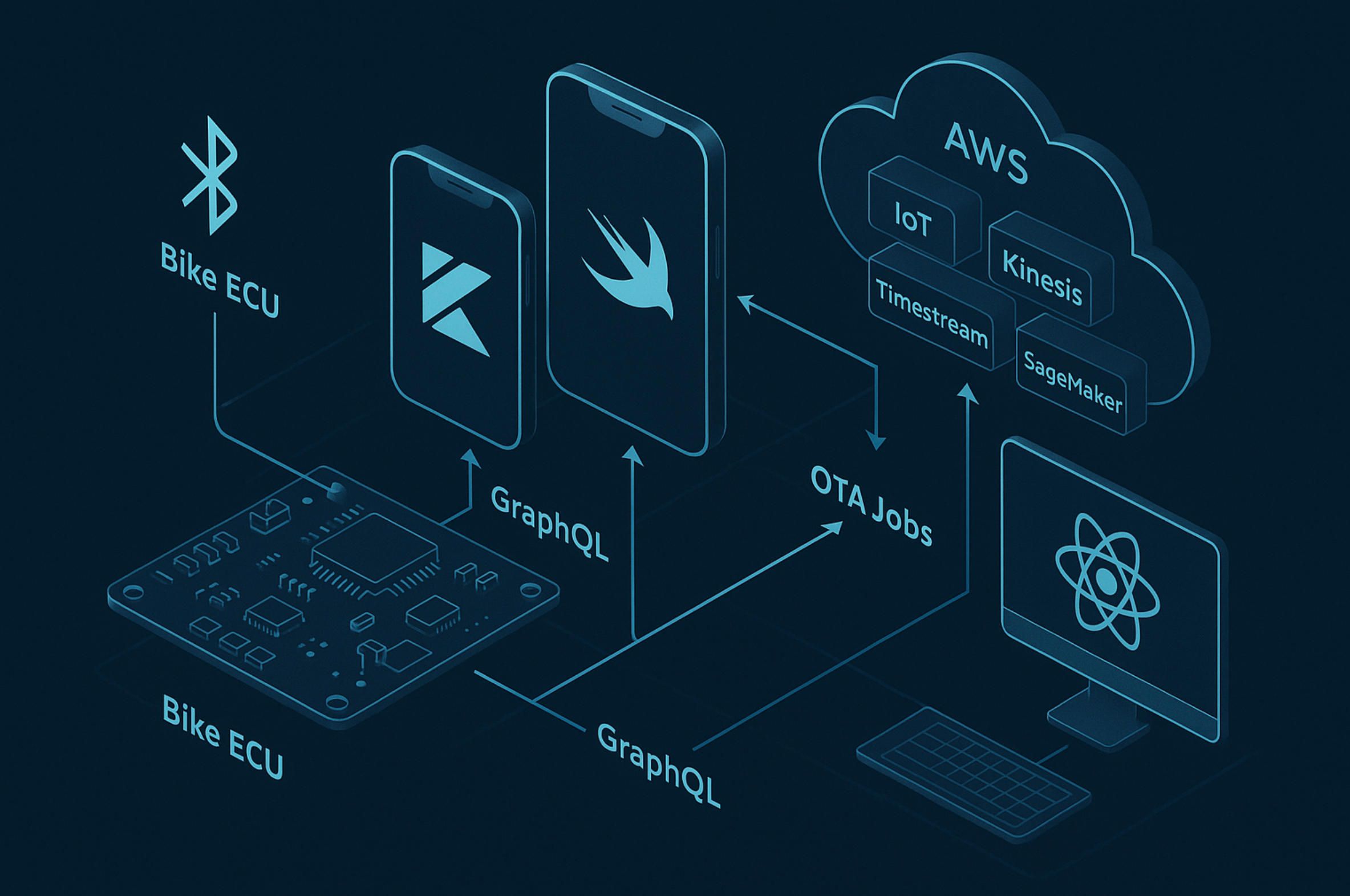
3. Build-to-Scale with A-Bots.com: Architecture, DevOps & Go-Live Roadmap
Turning terabytes of ride telemetry and a constellation of edge algorithms into a revenue-bearing product takes more than clever code; it requires a fully orchestrated hardware-to-cloud pipeline engineered for scale, security, and continuous evolution. Below is the blueprint A-Bots.com applies when we shoulder an eBike program from proof-of-concept to global fleet deployment.
3.1 Reference Architecture: From Spoke to Serverless

Edge Tier (0–50 ms budget).
- Bike ECU (ST M33 + FreeRTOS) performs PAS loops, crash detection and UWB lock. Packets adopt a 32-byte Protobuf schema aligned with the emerging Open-EBike 0.9 spec, keeping RF airtime under 1 % duty even at 10 Hz sampling.
- Firmware-defined QoS. Latency-critical notifications (SOS, thermal derate) are given
qos=1on BLE GATT; bulk logs (qos=0) defer until Wi-Fi.
Mobile Tier (50–300 ms).
- Kotlin Multiplatform shares business logic with SwiftUI to ensure parity across iOS 17 + and Android 14. Reactive streams (Flow/Combine) absorb sensor packets, run terrain-aware shifting and predictive range, then render in a declarative UI at 60 fps.
- Edge ML Inference. ONNX-Runtime Mobile hosts a 2.6 MB GPR model for adaptive PAS and a 4.8 MB CNN for pothole detection; peak CPU < 45 % on A-series silicon.
Cloud Tier (≥ 300 ms).
- AWS IoT Core terminates mutual-TLS with an ATECC608A root. Rules push high-frequency sensor topics to Kinesis Data Streams; lower-rate metadata lands in DynamoDB.
- Time-Series Analytics. Timestream retains raw telemetry for 180 days; roll-ups (5 s→5 min→1 h) live forever at 1 % of the cost.
- Machine-Learning Ops. Feature pipelines in SageMaker Pipelines retrain RUL and CP models weekly. A/B variants are canary-deployed to 1 % of the fleet via IoT Jobs with automated rollback on anomaly spikes.
- OEM Portal. A React dashboard served from AWS Amplify surfaces fleet health, firmware campaigns and revenue analytics from geo-fenced upsells.
3.2 Secure DevOps: “Bikes-as-Code”
| Stage | Tooling & Method | Latency / SLO |
| CI | GitHub Actions → self-hosted arm64 runners with Zephyr HIL targets | Build + unit test < 8 min | | CD | Argo Workflows triggers IoT Jobs for ECU; Fastlane for APK/IPA | Staged ring deploy: 1 % ➝ 5 % ➝ 100 % in 24 h | | Monitoring | Grafana Cloud dashboards fed by Prometheus (mobile) + CloudWatch (cloud) | p95 API latency ≤ 120 ms | | Alerting | PagerDuty; OpsGenie fallbacks | Critical TTR < 15 min |
- Infrastructure-as-Code. Terraform modules encapsulate BLE GATT UUIDs, IAM policies, and VPC templates so that a one-line version bump propagates across firmware, app and cloud in lockstep—eliminating the class of schema-drift bugs that plague multi-vendor stacks.
- Static & Dynamic AppSec. Every pull request passes Snyk and OWASP ZAP scans; run-time protections include AWS WAF with rate-based rules derived from historical traffic baselines.
- Hardware-in-the-Loop Regression. A-Bots.com maintains a rack of robotic bottom-brackets, linear actuators and thermal chambers. Each firmware commit replays 1 h of synthetic ride vectors in ≈ 9 min, catching PAS timing regressions before the nightly build hits QA.
3.3 Compliance & Data Governance
- GDPR & CCPA by Design. Personal data (rider profile, crash SOS) is encrypted at rest with AWS KMS; pseudonymised IDs isolate occupational telemetry (battery, motor) for OEM analytics. A Data Protection Impact Assessment is generated via automated Terraform Compliance and stored in AWS Artifact.
- ISO 4210-10 Electrical Safety. ECU firmware embeds a motor-stall watchdog; self-test results are signed and bubbled through the stack, appearing as a green badge in the mobile service menu—a paperless audit trail.
- UNECE R 168 Speed-Pedelec Limits. Geo-fenced firmware unlocks comply with local legislation; legal configurations reside in an immutable Parameter Store namespace, preventing sideload hacks.
3.4 Go-Live Roadmap: 36 Weeks to Global Roll-Out
Phase 0 — Discovery (Weeks 0–2)
- Joint workshops to lock sensor SKU, UX personas and acceptance KPIs (e.g., predictive range error p50 < 8 %).
- Rapid architecture spike using A-Bots.com “eBike-Starter-Kit”: pre-certified BLE stacks, MQTT schemas and a React OEM portal stub.
Phase 1 — Alpha Hardware & MVP App (Weeks 3–12)
- Assemble ten Alpha A bikes with full sensor complement.
- Deliver MVP mobile app: live telemetry stream, adaptive PAS v0.7, OTA-capable ECU.
- Outcome: field data ≥ 150 ride-hours for algorithm calibration.
Phase 2 — Beta Pilot at Scale-10× (Weeks 13–24)
- Manufacture 100 Beta bikes across three frame sizes; onboard test riders via TestFlight / Play Store internal track.
- Enable crash detection, predictive range and remote diagnostics.
- Weekly ML retrains refine PAS hyper-parameters; target PAS latency p95 < 40 ms.
Phase 3 — Soft Launch (Weeks 25–30)
- Activate eSIM profile; provision LTE-M fallback and Find-My-Bike.
- Integrate with payment gateway (Stripe Connect) for geo-unlock upsells.
- Pen-testing by third-party (e.g., Bishop Fox); remediate CVEs ≤ P2.
Phase 4 — Full Commercial Release (Weeks 31–36)
- Push production firmware/app via phased % roll-out; monitor for regression alarms.
- Open OEM portal to dealer network; parts forecasting fed by RUL dashboards.
- Marketing sync: publish metrics case study (“18 % warranty ticket reduction”) and App Store-optimised screenshots.
3.5 Scaling Patterns & Cost Model
3.5.1 Telemetry Throughput
Let n be active bikes, each transmitting s bytes s⁻¹ at frequency f Hz. Total inbound Kinesis rate λ is:
λ=n×s×f
At 100 kB s⁻¹ per bike @ 10 Hz, a 50 k fleet yields λ = 5 MB s⁻¹. Our three-shard Kinesis stream (shard capacity = 1 MB s⁻¹) scales to 15 MB s⁻¹ headroom; autoscaling policies add shards at 70 % utilisation.
3.5.2 Serverless Cost Projection (US-East-1)
- IoT Core: $1 per million messages → ≈ $150 month for 50 k fleet
- Timestream Storage: $0.023 GB-month; raw + roll-up ≈ 1.2 TB month → $27
- Lambda Compute: 2 B$ λ-invocations, 256 MB, 100 ms avg → ≈ $90
Total per-bike cloud OPEX <$0.006 month, leaving abundant margin for premium SaaS upsells.
3.6 Observability & Continual Improvement
| Metric | Dashboard | Trigger | Automated Response |
| Crash FP rate > 0.05 % | Grafana | 3-day rolling | Retrain crash model | | PAS latency p95 > 45 ms | CloudWatch | Real-time | ECU rollback via IoT Jobs | | OTA failure > 0.5 % | Amplify | Per release | Pause staged roll-out | | RUL MAE > 5 % | SageMaker | Weekly | Hyper-parameter sweep |
Automated hooks shorten mean-time-to-innovation: a PAS regression detected at midnight yields a green build with patched parameters before the European commute window.
3.7 Why OEMs Choose A-Bots.com for Scale
- Single-SLA Ownership. Bike firmware, mobile UX, cloud telemetry and DevOps live under one contract; no finger-pointing across vendors.
- Field-Hardening DNA. Our algorithms power fleets in −20°C Almaty winters and 45°C Dubai summers; sensor fusion already bakes in temperature compensation curves.
- Revenue Multipliers. Geo-fenced unlocks, DaaS resale and predictive spares logistics add software EBITDA on top of hardware margin.
- Transparent Partnership. You retain IP; we accelerate your roadmap with reusable modules and 24 ⁄ 7 ops coverage.
Ready to accelerate?
Drop us a line at info@a-bots.com or book a 30-minute architecture whiteboard session. We’ll bring the HIL demos—and a blueprint to turn your next eBike line into a data-driven, continuously evolving mobility platform.
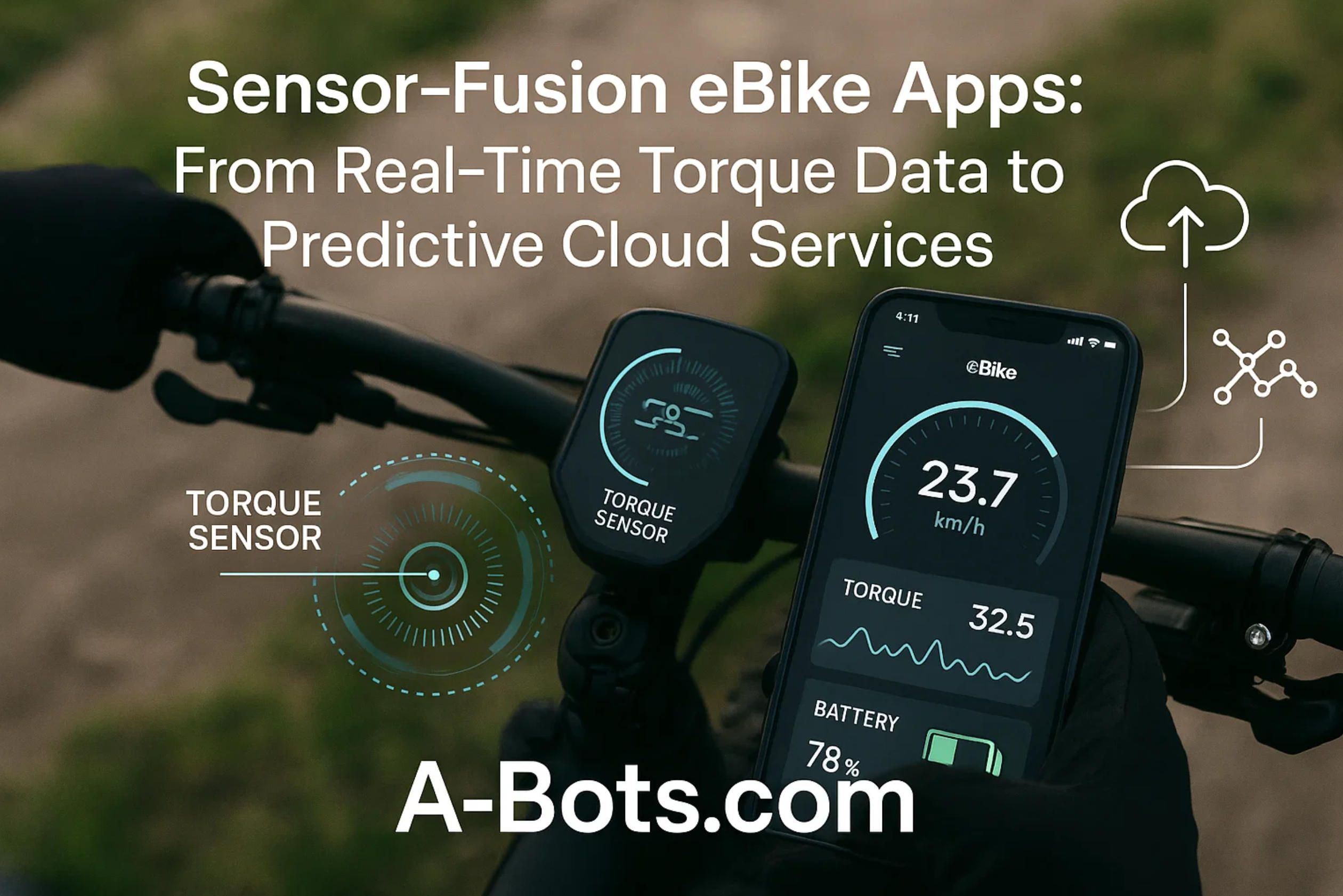
✅ Hashtags
#EBikeApp
#SensorFusion
#MobileDev
#IoTSoftware
#ABots
#EBikeDevelopmentCompany
Other articles
ShelterHeart: Crowdfunded Pet Shelter App ShelterHeart is a next-generation mobile platform that bridges animal lovers and shelters through sponsorship, adoption and data-driven care. On the user side, supporters enjoy one-tap monthly donations, live health dashboards and even AR meet-and-greets with future furry friends. For shelters, an integrated Command Center replaces scattered spreadsheets with real-time inventory forecasts, AI adoption matching and grant-ready analytics. Architected by A-Bots.com on a fault-tolerant, microservice stack, the solution scales seamlessly from a single local rescue to a global, multi-tenant network—all while meeting GDPR, CCPA and veterinary compliance standards. The article outlines a phased crowdfunding strategy: seed a passionate community, validate demand with lightweight landing pages, then launch a tiered Kickstarter or Patreon campaign to finance the MVP. With transparent ROI metrics and white-label options, ShelterHeart empowers nonprofits to deploy life-saving technology without prohibitive upfront costs, turning every swipe into a tangible act of kindness.
Mobile Apps for E-Bike or Scooter Urban mobility is shifting from private cars to agile fleets of shared e-bikes and scooters. Yet hardware alone cannot deliver uptime, safety, or profitability. The real engine is a custom mobile platform that unifies GPS, battery health, rider scoring, and dynamic pricing. This article dissects a market projected to exceed $50 billion by 2030 and shows why off-the-shelf dashboards fall short. We map the technical stack—from vehicle CAN-bus to real-time payment APIs—and expose hidden revenue levers like predictive maintenance and congestion-aware geofencing. Real-world examples illustrate both the growth hacks and the compliance pitfalls. Finally, we explain how A-Bots.com turns data exhaust into ROI for operators and safer rides for cities.
Explore DoorDash and Wing’s drone delivery DoorDash and Wing are quietly rewriting last-mile economics with 400 000+ aerial drops and 99 % on-time metrics. This deep dive maps milestones, performance data, risk controls and expansion strategy—then explains how A-Bots.com turns those insights into a fully-featured drone-delivery app for your brand.
Smart Solar and Battery Storage App Solar panels and batteries are cheaper than ever, but real value emerges only when software choreographs them minute by minute. This in-depth article tracks the cost curves reshaping residential energy, explains the app architecture that forecasts, optimises and secures every dispatch, and unpacks the grid-service markets that now pay households for flexibility. Packed with field data—from NREL bill-savings trials to Tesla’s 100 000-home virtual power plant—it quantifies user ROI across savings, resilience and sustainability. The final section details why A-Bots.com is uniquely positioned to deliver such platforms, fusing AI forecasting, IEC-grade cybersecurity and award-winning UX into a turnkey solution. Whether you build hardware, aggregate DERs or own a solar roof, discover how intelligence—not silicon—unlocks the next decade of energy value.
Top stories
Copyright © Alpha Systems LTD All rights reserved.
Made with ❤️ by A-BOTS
